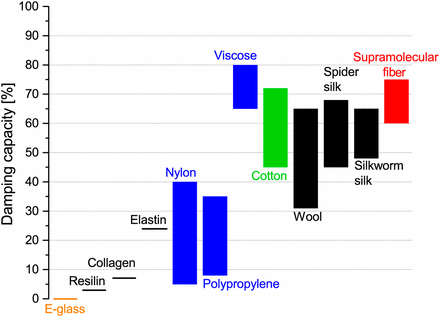Supramolecular Fibres
Stronger than silk, this phase-changing material transforms to a solid when drawn from a hydrogel reservoir. The low-energy manufacturing for this material promises a sustainable future.
THE GIST
Supramolecular fibres are cellulose derivatives, which are sugar-based polymers. They are composed of silica nanoparticles and a combination of carbon, hydrogen, nitrogen and oxygen (cucurbituril 8) (National Center for Biotechnology). These fibres have similar mechanical properties to silk, based on their strength and ductility, as well as their high dampening capabilities.
Oren Scherman – the director of the lab for polymer synthesis at University of Cambridge – stated that the fibres’ extremely uniform 6-micron diameter showed a high potential for reproducibility. The material could be woven into larger sheets due to this reproducible potential. The fibres could also be combined with a photo-crosslinking agent that could reduce swelling, and therefore enable it for external applications.
The chemical self-assembly of the supramolecular fibres in a hydrogel reservoir results in a low-energy manufacturing process.
The scientists created and experimented with the material at the Cambridge University bio-engineering lab. The scientists used a machine to mechanically draw the fibre from a hydrogel reservoir with separating plates, the photo below demonstrates the process used:

During the drawing of the material from the reservoir, a rapid liquid–solid phase transition occurs. Using the machine,they discovered that the fibre length could increase while the diameter remained constant. The scientists state that the diameter may be tuned by parameters such as gel viscosity, surface tension and humidity.
Benefits and Applications
As a dampening material, it is a good candidate for energy absorption in buildings. It could be used to absorb vibrations from earthquakes as well as noise. These fibres could be adhered to the joints / interfaces of engineered wood for absorption of earthquake vibrations. The material is highly ductile and can therefore conform to a variety of complex geometries. The graph below shows the dampening capacity of supramolecular fibres compared to similar fibres.

As the material is still in the experimental phases, scientists continue to advance on its biomimetics, such as its degree of water absorption and contraction. The dissolution of the fibres in water can be prevented by UV crosslinking, though it compromises the fibres’ tensile strength, likely by locking the defects —such as internal voids—in place (Wu Y. , et al., 2018).
Commercial Readiness
As stated,the fibre shows high potential for reproducibility. To commercialise the fibres,they could be woven to create sheets, but the weaving machine would need to be created to suit the specific properties of the fibres (personal communication,Oren Sherman, May 2020).
Cost Analysis
One of the base materials, hydroxyethylcellulose(HEC) can be purchased from online third-party seller Ali Baba for $10-$25 per kilogram. HEC is a cellulose derivative that is more soluble than the parent cellulose. To functionalise this material a ‘guest’ molecule capable of binding the macrocycle, cucurbit[8]uril (CB[8]) is required. CB[8] costs $87 USD per 25mg according to STREM chemicals incorporated. Silica colloids (around 50 nm in diameter) need to be prepared and functionalised with a polymer that alsocarries a complementary ‘guest’ molecular for CB[8]. 10 mg/ml of silica colloids with a 50 nm diameter can be purchased from online third-party seller Amazon for $65 USD, These are produced by Alpha Nanotech inc. Then, the functionalised silica nanoparticles are mixed together with the HEC, CB[8] and water and you have your gel (reservoir). The majority of the volume of the gel is water (98%) anc HEC, CB[8] and silica nanoparticles comprise the remaining 2%. The materials used to make the hybrid hydrogel area are all commercially available, and the largest components are the cellulose derivatives (HEC) and silica particles (SiO2).
Tensile testing machines similar to the Instron model (used in the testing data) range from $1500 to $5000 based on a variety of estimates from manufacturers.
What's next?
This promising material could create spider-silk like structures or caves, similar to the one created by the MIT lab using real spiders. This could unlock an entirely new way of building and creating shelter for humans.
Machines to create structures from this specific material need to be created as the manufacturing process differs from anything currently existing due to its phase changing nature.

